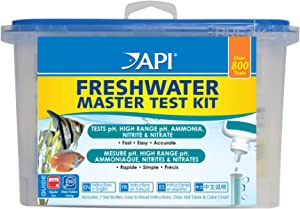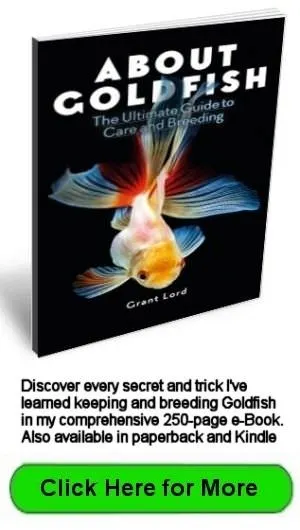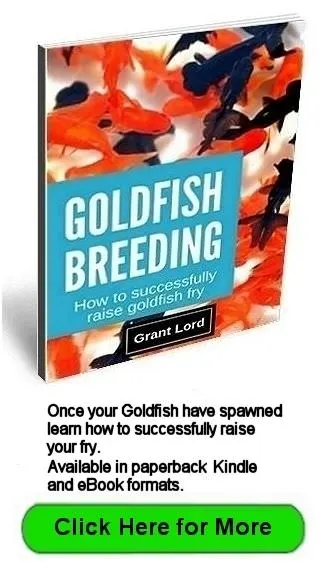- Home
- General Care
Goldfish Care - Avoiding Basic Mistakes
Most Goldfish die because they aren’t provided with the basic
care needs of good water quality, a varied diet, and room to grow.
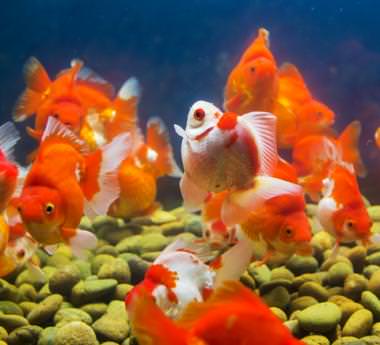 School of Ryukins displaying excellent health
School of Ryukins displaying excellent healthGoldfish care is easy, but before you start getting any fish, you need to make a few decisions:
- Am I keeping them indoors in an aquarium or outdoors in a pond?
- What variety or varieties do I want to keep as not all varieties can live together?
- What size Goldfish do I want? Do I want to grow them up myself or purchase adults?
- Do I want to breed them?
- How much room do I need for the aquarium/pond and equipment?
Water Changes Are The Secret To Goldfish Care
There is only one thing you need to do regularly that will make your Goldfish keeping trouble-free.
MAKE LARGE WATER CHANGES REGULARLY.
Changing the water regularly does four things:
- It regulates pH, (the invisible killer)
- It removes nutrients so algae growth is controlled
- It keeps the water clear of any sediment build up
- It removes growth limiting hormones.
If the pH drops below 7.0, the nitrate level rises above 20 ppm (parts per million), or the ammonia level is above zero, a partial or complete water change is required.
I've seen overfed, cramped Goldfish thriving because the owner made frequent water changes.
Use a multi-purpose test kit to learn how often you need to make partial water changes. How often will depend on the size of your pond or aquarium, the amount of food going in, and the number and size of fish being kept.
Just because water is clear doesn’t mean the pH, ammonia, and nutrient levels are safe.
Water Conditions Always Need To Be Checked
There are three important water conditions that should always be checked before moving Goldfish from one container to another.
- Water chemicals
- Water temperatures
- Water pH
To kill dangerous pathogens water straight from the tap contains chlorine or chloramine. These chemicals can kill Goldfish if not removed with a water conditioner. Chlorine can be left to gas off overnight with the aquarium filter or an air stone running, but chloramine can only be safely removed with a water conditioner. (Both chemicals will also kill off the good bacteria in an established filter).
Never use pure rainwater, the lack of chemicals in it means it cannot support life.
There will probably be a temperature difference between the water the Goldfish are in, and where they are being moved to. Check it with an aquarium thermometer. The maximum difference should be no more than 5 degrees Fahrenheit (2.78C).
There will almost certainly be a difference in pH, which I call the invisible killer. More new arrivals are killed by pH differences than any other reason.
Goldfish can be safely moved to water with a higher pH reading, as long as it is in the safe range of 7.0 to 7.6, but never one with a lower reading unless very slowly acclimatized. The ideal pH for Goldfish is 7.4.
Fresh clean water will generally have a higher pH reading than aged water but never assume and always use your test kit to confirm the figure.
Goldfish Need Variety In Their Diet
Goldfish are omnivorous, so their food sources include plant material and any animal they can fit into their mouths. This usually consists of worms, insect larvae, small fish, including other Goldfish, and fresh water crustaceans such as daphnia.
Their dietary needs change as they get older, with fry (babies) and juvenile fish requiring a high protein diet for growth, while adult fish need more plant material in the diet.
The fancier the Goldfish variety you are keeping, the more important it is to give them a balanced diet with some live food, whether fresh or frozen, to avoid digestive and swim bladder problems.
Dry prepared foods readily available from pet stores are not suitable as the staple diet for Goldfish because they lack the essential elements that all prepared foods lack.
A growing trend these days is to feed gel foods, which offer several advantages over dry prepared foods:
- They are soft and moist, so are easily chewed and swallowed
- They are high in protein and vegetable matter, so provide a balanced diet
- They cause little pollution of the water as they don't dissolve quickly.
To learn more about feeding Goldfish, go to the Feeding Goldfish page.
How Much Room Do Goldfish Need?
Goldfish are messy creatures, and can grow quite large given the right conditions. Because of this they need more gallons of water, and most importantly, more square inches of surface area per inch of fish than do tropical fish.
The basic calculation is 24 square inches (155 sq cm) of water surface area per inch (2.54 cm) of fish (excluding the tail fin).
This figure is only a guide, but it highlights the importance of surface area and not water volume.
As an example, if an aquarium is a tall design as some tubular acrylic display aquariums are, without filtration it will support less fish than an aquarium that is longer than it is tall with the same volume of water.
Go to this page for more detailed information on how much room Goldfish need.
In any aquarium or pond fish numbers can be doubled if one of the many filtering options available is used.
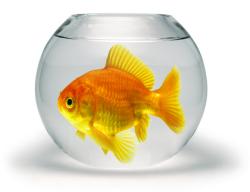 Bowls are not suitable for Goldfish
Bowls are not suitable for GoldfishIf Goldfish are kept in a pond, the square inches of surface area per inch of fish should be doubled if you don't have a filtering system. This is because outside ponds are subject to more climatic extremes such as heat and cold.
Leaves, dust and other debris also find their way into garden ponds, putting additional biological strain on the water’s ability to break them down naturally into harmless chemicals.
You can now work out how many Goldfish you can keep in the area you plan to use.
Don’t forget to also include some space for nets, siphoning hoses, chemicals and other equipment you tend to accumulate with fish keeping.
If the Goldfish will be kept indoors, access to some bench space and a sink is useful to wash and sterilize equipment.
Choosing a Suitable Home For Your Goldfish
Your next decision is to choose a suitable aquarium and filtering system, or construct a pond.
There are many options available these days at very competitive prices. Learn about the different options by visiting the pages on aquariums, filters and ponds. One of the most important decisions is where to put your aquarium or pond to make maintenance easier.
Once you have your Goldfish aquarium or pond set up, you can now purchase your Goldfish, safe in the knowledge that their home is well sited, well lit and of the correct size for the numbers you intend to keep.
New Aquariums and Ponds Must Go Through The Nitrogen Cycle
Learn about the nitrogen cycle when setting up an aquarium because when you transfer your fish from quarantine into their new home, you want the aquarium to have become established and gone through the nitrogen cycle.
Ammonia poisoning is a big killer of aquarium fish because a newly set up aquarium goes through an ammonia spike during the biological establishment of the filter.
How To Buy Healthy Goldfish
Go to the Choosing Goldfish page where we discuss how to buy healthy fish, get them home safely and correctly introduced into the sick bay for a two week quarantine period.
If the fish you purchase are looking healthy when you buy them, you have made an excellent start. Goldfish care is so much easier if healthy fish are purchased rather than buying sick fish that will take a lot of time and resources to cure.
This page also discusses Goldfish compatibility. You can't keep a Comet with a Black Moor because the Comet will always get to the food first, and the Black Moor will slowly starve.
Tip:
Limit the numbers and varieties you keep at first. It would be nice to have a few specimens of several varieties, but each variety often has its own unique requirements. Until you become more experienced, keep one or at most two varieties that can co-exist together. This will make looking after your Goldfish much easier.
Make Maintaining The Aquarium Easy
Nobody likes maintaining an aquarium, but it is an important part of goldfish care.
If you set up your aquarium using tricks learned from my aquarium hire business, you will rarely have to completely break down an aquarium. On the Aquarium Cleaning page I have detailed what simple equipment you need to make your regular water changes easier, and other tricks that cut maintenance time to the bare minimum.
A Sick Bay Is An Essential Piece Of Equipment
An often overlooked item is the sick bay. You will need room for a sick bay to quarantine new arrivals and when, not if, a fish becomes sick or injured.
There is nothing worse than setting up an aquarium or pond and then noticing that one or all of the fish are showing signs of disease, usually a few days after being introduced.
If the disease is a parasite infestation, it can be assumed all the fish are carrying the parasite. The best option is to treat all the aquarium or pond inhabitants with a medication that doesn’t kill plants or filter bacteria colonies.
If the disease is bacterial or fungal, a sick bay is the only option as any medications used for these conditions kill plants, filter bacteria, and make the aquarium gravel toxic.
Breeding Containers
If you plan to breed your goldfish, you really need an outdoor container of about 80 gallons (two would be better), and an extra aquarium of about 15 gallons for hatching the eggs in.
I used the term container instead of pond because you need to be able to clean and sterilize it easily. An in-ground pond isn’t really suitable. You will use the outdoor container to breed the adults in and raise about 40 fry for 3 months.
Goldfish Dangers and Enemies
Keeping your Goldfish indoors in an aquarium or outdoors in a covered pond does keep them safe from natural enemies. But, there are many other dangers that are created because of the confined space and small water volume they live in.
Learn more about Goldfish dangers...
Covering a pond does keep adults safe from the usual culprits such as cats and birds, but small fry can still be attacked by a variety of airborne insects.
Learn more about natural Goldfish enemies...
In Summary...
- Give them enough room to grow; allow about 10-20 gallons for each adult fish
- Make frequent large water changes, ensuring there are no large differences in water temperature or pH, and chlorine or chloramine has been removed from the water
- Feed them a variety of fresh plant and animal based foods. This is especially important for the fancy varieties if you want to avoid digestive and swim bladder problems.
- Buy healthy fish
- Don't mix varieties where competition for food will be unequal. Keep single tailed varieties together, and keep normal eyed fish with normal.
